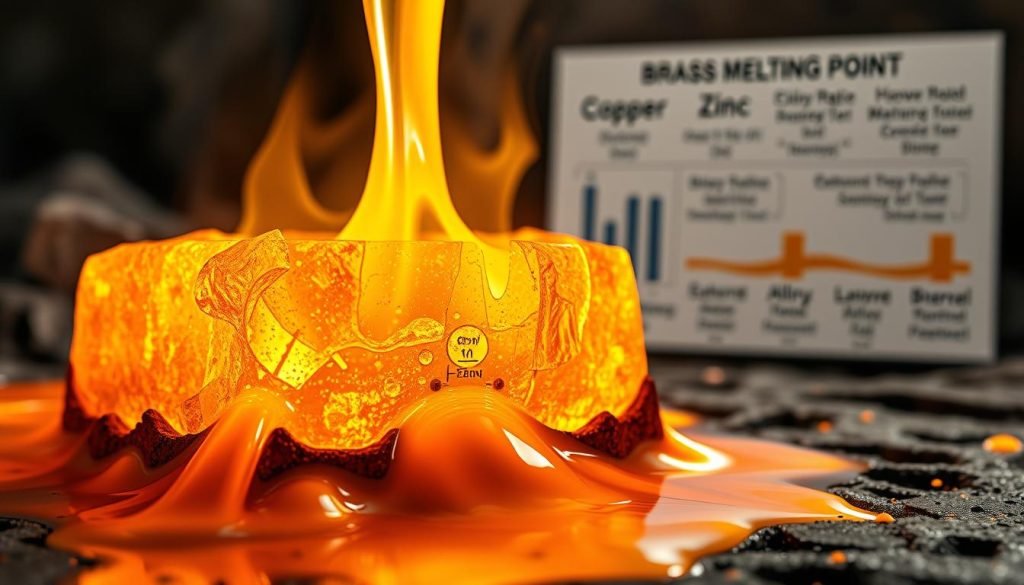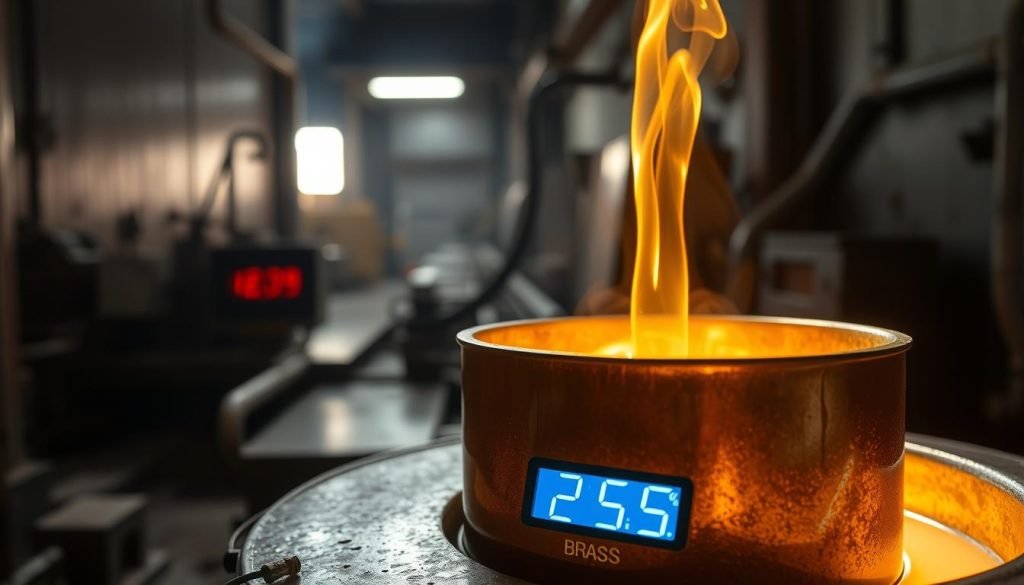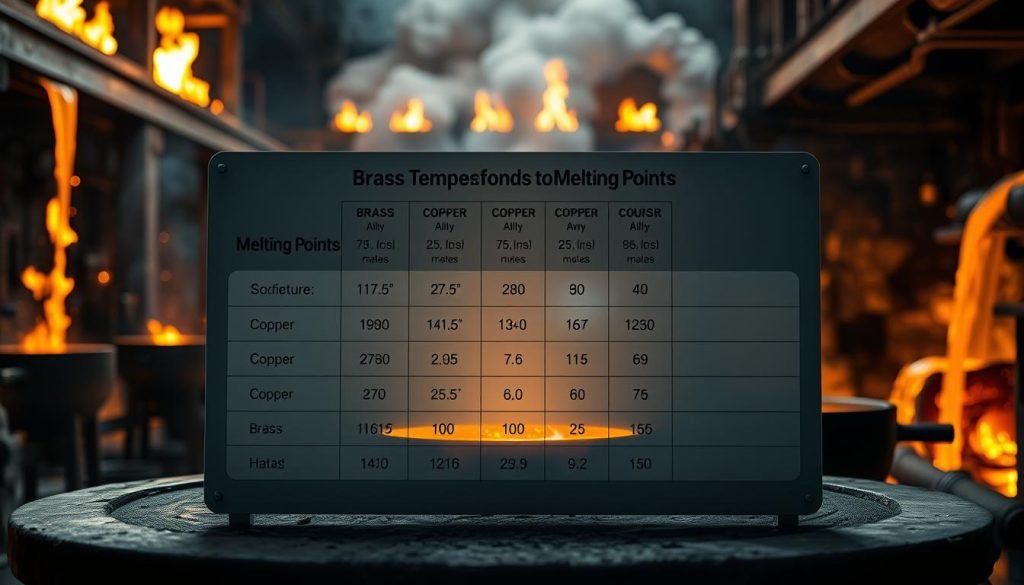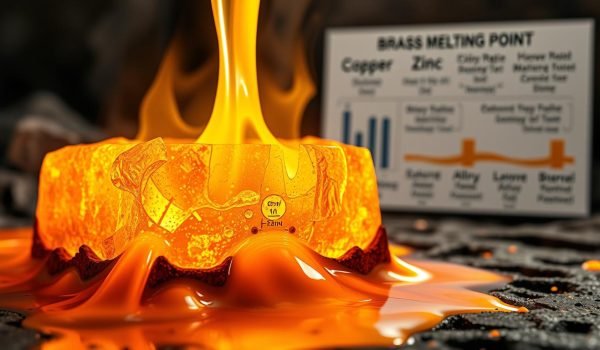Did you know that the melting temperature of brass, a versatile alloy made from copper and zinc, varies significantly based on its composition? This variation is crucial for industries relying on brass for manufacturing and engineering applications.
The melting point of brass typically ranges between 890°C and 1000°C, influenced by the proportions of copper and zinc. Understanding this range is essential for proper material selection and manufacturing processes.
As you explore the world of brass, you’ll discover that different grades have distinct melting points, affecting their suitability for various applications. This guide will walk you through the melting points of various brass grades, factors influencing these temperatures, and practical applications of this knowledge.

Understanding Brass and Its Composition
Understanding brass requires knowledge of its composition, particularly the copper-zinc ratio, which influences its properties. Brass is an alloy made primarily of copper and zinc, and its characteristics can vary widely based on the proportion of these elements.
What is Brass?
Brass is a versatile alloy used in a wide range of applications due to its unique properties, such as corrosion resistance and ductility. The content of copper and zinc in brass can vary, resulting in different types of brass alloys with distinct characteristics.
Copper-Zinc Ratio and Its Significance
The copper-zinc ratio is the most critical factor determining brass properties, including its melting point, strength, ductility, and workability. As the zinc content increases, the properties of brass change significantly. For instance, brass with 18-20% zinc content has a reddish-yellow appearance, while a zinc content between 20-30% results in a brownish-yellow color.
| Zinc Content (%) | Appearance | Properties |
| 18-20 | Reddish-Yellow | Good corrosion resistance, ductile |
| 20-30 | Brownish-Yellow | Improved strength, suitable for hot processing |
The copper-zinc ratio affects not just the appearance but also the mechanical properties of brass. Higher copper content generally results in better corrosion resistance but lower strength, while higher zinc content improves strength but may reduce ductility. Manufacturers select specific copper-zinc ratios based on the intended application requirements, including temperature resistance needs.
What is the Melting Point of Brass?
Brass, an alloy of copper and zinc, has a melting point that varies based on its composition. The melting behavior of brass is a complex process influenced by its copper-zinc ratio and other alloying elements.
General Melting Range
The melting point of brass is not a single temperature but a range. Typically, brass starts to melt at a temperature known as the solidus temperature and is completely molten at the liquidus temperature. For most brass alloys, this range falls between 900°C to 940°C (1652°F to 1724°F).
| Brass Type | Solidus Temperature (°C) | Liquidus Temperature (°C) |
| Alpha Brass | 900 | 930 |
| Beta Brass | 880 | 920 |
How Composition Affects Melting Temperature
The composition of brass, particularly the proportion of zinc to copper, significantly affects its melting point. As the zinc content increases, the melting point generally decreases. Other elements added to brass, such as lead or tin, can also influence its melting behavior.
The Melting Process Explained
When brass is heated, it undergoes thermal expansion before reaching its melting point. As it reaches the solidus temperature, it begins to soften and eventually becomes a mixture of solid and liquid phases. This semi-solid state continues until it reaches the liquidus temperature, at which point it becomes fully molten. Understanding this process is crucial for foundry operations.
Melting Temperatures of Various Brass Grades
Different brass grades have distinct melting temperatures, influenced by their composition. Brass alloys are categorized into various grades based on their composition and properties, and understanding their melting temperatures is crucial for their application in different industries.
Alpha Brass Alloys
Alpha brass alloys, which contain a higher proportion of copper, have a relatively lower melting point compared to other brass grades. These alloys are known for their ductility and are often used in applications requiring cold working. The melting temperature of alpha brass typically ranges around 900°C to 940°C (1652°F to 1724°F).
Beta Brass Alloys
Beta brass alloys, with a higher zinc content, exhibit higher strength and a different crystal structure compared to alpha brass. Their melting point is generally higher, ranging approximately from 900°C to 960°C (1652°F to 1760°F). Beta brass is more suitable for high-temperature applications and has better machinability.
Common Commercial Brass Types
Common commercial brass types, such as cartridge brass (70% copper, 30% zinc) and yellow brass, have melting temperatures that fall within the range of alpha and beta brass alloys. Cartridge brass, for instance, melts between 900°C to 940°C (1652°F to 1724°F), while yellow brass has a slightly broader melting range. These brasses are widely used in various applications, including hardware and musical instruments, due to their favorable mechanical properties and relatively low melting points.
Special Brass Alloys and Their Melting Points
Special brass alloys, such as Aluminum Brass, White Brass, and Silicon Brass, are formulated for specific applications where standard brass compositions are not suitable. Aluminum Brass, containing 2-3% aluminum, has a melting temperature of 1027-1038°C (1881-1900°F) and is valued for its strength and corrosion resistance. White Brass and Silicon Brass also exhibit unique properties and melting characteristics, making them ideal for complex castings and marine applications. The melting points of these special alloys are crucial for their processing and application.
Factors Affecting the Melting Point of Brass
The melting point of brass is influenced by several key factors that you should understand for optimal processing. These factors can significantly impact the melting behavior and overall quality of the final product.
Zinc Content and Its Impact
The zinc content in brass is a primary factor affecting its melting point. As zinc percentage increases, the melting point generally decreases. This is because zinc has a lower melting point than copper, and its addition alters the alloy’s thermal properties.
Effect of Additional Alloying Elements
Besides zinc, other alloying elements can be added to brass to modify its properties. Elements like lead, tin, or aluminum can lower or raise the melting point, depending on their concentration and interaction with copper and zinc. These elements can also affect the alloy’s strength, corrosion resistance, and machinability.
Grain Size and Structure
The grain size and structure of brass also play a crucial role in its melting behavior. Finer grain structures tend to have different melting characteristics compared to coarser grains. The processing history of the brass, including casting, rolling, or annealing, can influence its grain structure and, consequently, its melting point.
Impurities and Their Influence
Impurities, even in small amounts, can significantly affect the melting point of brass. Elements like sulfur, phosphorus, or oxygen can form low-melting-point compounds with copper or zinc, potentially creating weak spots. Conversely, some impurities like iron can form high-melting intermetallic compounds that may cause casting defects.

How to Melt Brass Properly
Achieving high-quality results when melting brass depends on a thorough understanding of the melting process. To ensure you’re working with the best possible techniques, it’s crucial to consider the equipment, safety measures, and step-by-step procedures involved in melting brass.
Equipment and Safety Considerations
When melting brass, the right equipment is essential for both safety and quality. You’ll need a crucible that can withstand high temperatures, a furnace or torch capable of reaching the necessary melting temperature, and proper ventilation to remove fumes. Safety gear, including heat-resistant gloves, goggles, and a face mask, is also vital to protect against burns and inhalation of hazardous particles.
Step-by-Step Melting Process
The melting process involves several key steps. First, prepare your brass materials by cleaning and sorting them. Next, place the brass in the crucible and heat it gradually to the melting point, typically between 900°C to 1000°C, depending on the brass grade. Monitor the temperature closely and maintain it within the optimal range. Once melted, skim off any dross or impurities before casting.
Common Challenges and Solutions
Several challenges can arise during the brass melting process, including zinc volatilization, oxidation, contamination, and temperature control issues. To address these, use proper flux to prevent oxidation, ensure thorough material sorting and crucible cleaning, and maintain precise temperature control. Additionally, implementing degassing techniques and proper mold design can help minimize porosity and other casting defects.
Comparing Brass Melting Points to Other Metals
To make informed decisions about material choices, it’s necessary to compare the melting point of brass with that of other metals. Brass has a melting point range of approximately 900-940°C (1650-1725°F), which is a critical factor in determining its suitability for various applications.
Brass vs. Copper
Brass has a lower melting point compared to copper, which melts at around 1085°C (1985°F). This difference affects their respective applications, with copper being more suitable for high-temperature environments. You should consider copper when your project requires high electrical conductivity and thermal resistance.
Brass vs. Bronze
While both brass and bronze are copper alloys, their melting points can vary significantly based on their composition. Generally, bronze has a higher melting point than brass, often above 950°C (1742°F), depending on the specific type. This makes bronze more suitable for certain high-temperature applications.
Brass vs. Common Industrial Metals
Comparing brass to other common industrial metals reveals its relative position in terms of melting points. For instance, aluminum melts at 660°C (1220°F), significantly lower than brass, making brass more suitable for higher-temperature environments. In contrast, carbon steel and stainless steel have higher melting points, ranging from 1425-1540°C (2597-2800°F) and 1375-1530°C (2500-2785°F), respectively. Other metals like zinc and lead have much lower melting points (420°C/787°F and 328°C/622°F, respectively), while titanium and tungsten have much higher melting points (1670°C/3038°F and 3400°C/6152°F, respectively).

Understanding these comparisons helps you select the most appropriate material for your specific application, considering factors beyond just melting point, such as strength, corrosion resistance, and cost.
Why Knowing the Melting Point of Brass is Crucial
Awareness of brass melting temperatures is essential for preventing structural failures in high-temperature applications. Knowing the melting point of brass is crucial for various reasons, including ensuring the quality and integrity of brass components in different manufacturing processes.
Understanding the specific melting point of different brass grades is vital for manufacturing processes such as casting, forging, welding, and heat treatment. This knowledge ensures optimal process parameters and energy efficiency, ultimately affecting the quality of the final product.
Melting point awareness is critical for quality control in brass manufacturing. Temperature variations during processing can significantly affect the microstructure, mechanical properties, and dimensional stability of the finished components. Knowing the melting point helps engineers properly specify brass for appropriate applications, avoiding potential failures in high-temperature environments.
Knowing the melting point of brass also aids in recycling and reprocessing, ensuring proper furnace settings and preventing excessive zinc volatilization. This knowledge is fundamental to alloy development, allowing metallurgists to create new brass formulations with optimized property combinations for specific applications.
Conclusion
The melting point of brass, a key property, varies significantly across different grades. Brass melting points typically range from 890°C to 1000°C (1650°F to 1830°F), depending on the alloy composition. The zinc content is the primary factor affecting the melting point, with higher zinc content generally resulting in a lower melting temperature. Understanding brass melting points is crucial for manufacturing processes and material selection. Different brass grades have been developed for specific applications, from decorative items to industrial components. Proper melting procedures and safety precautions are essential when working with molten brass.




